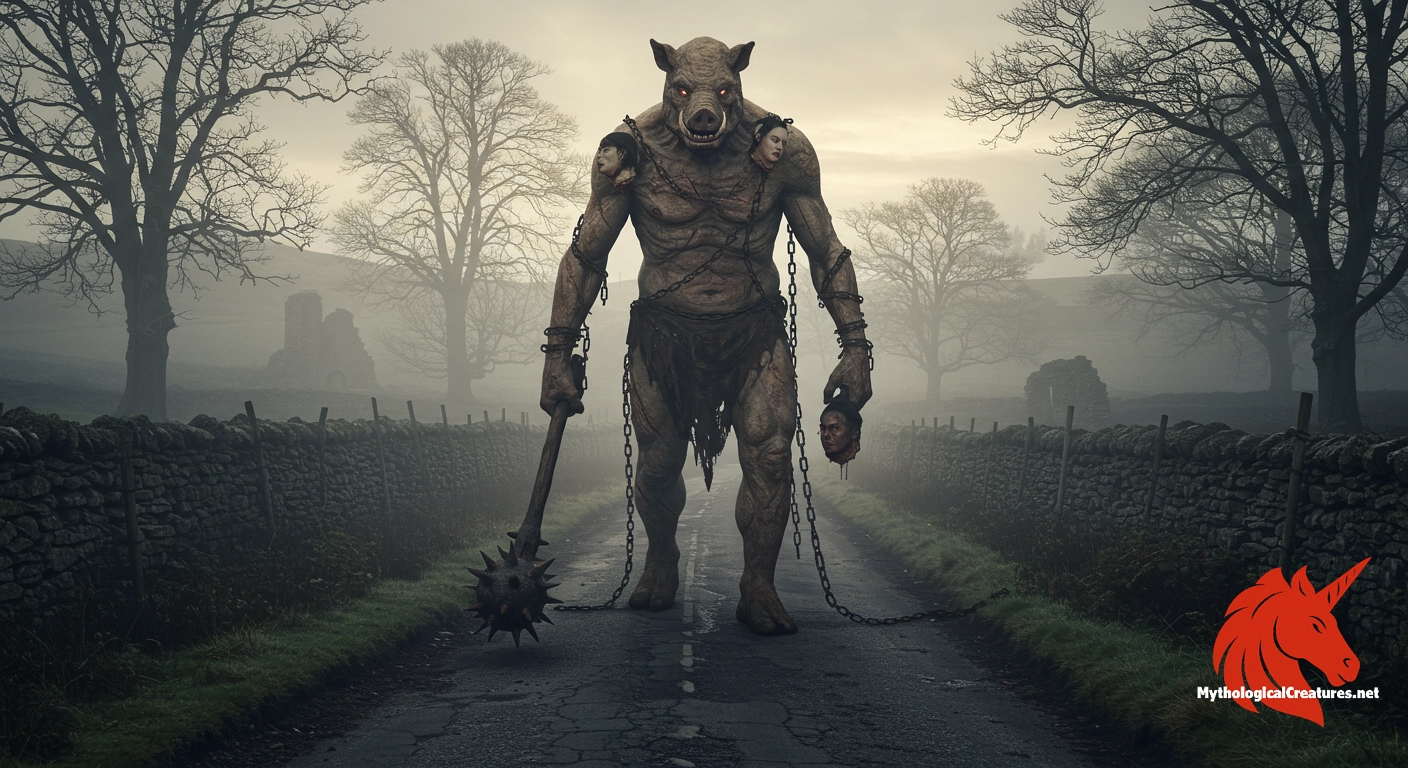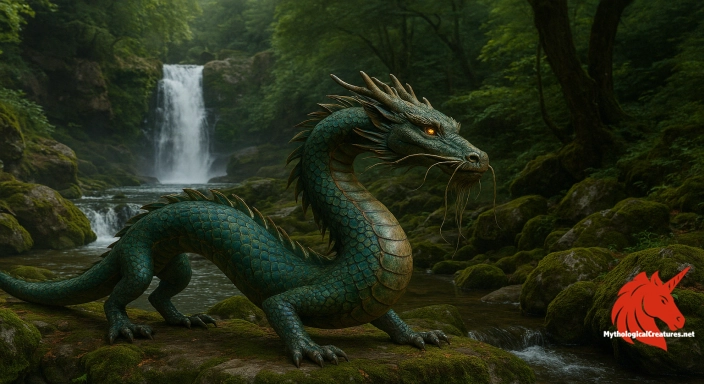Jack-in-Irons: Jack-in-Irons is a fearsome mythical giant from Yorkshire folklore.

Jack-in-Irons
Jack-in-Irons - Serves as a grim warning about the dangers lurking on remote roads.
Origins & First Encounters
Jack-in-Irons is a formidable and enigmatic giant whose legend has been woven into the fabric of Yorkshire lore for centuries. His origins are deeply linked with the remote, misty roads of the northern English countryside, where the shadow of his presence instilled both awe and terror. Emerging from a tradition of oral storytelling, he embodies both a cautionary tale and a symbol of the untamed wilderness that once scared off unwary travellers. The figure’s name, while reminiscent of other local legends like Jack in the Green, appears to have evolved into a generic reference to the unknown male, much like a John Doe of folklore. Early attestations indicate that his myth was nurtured in the minds of the local agrarian communities, who saw him as a manifestation of nature’s wrath and human fallibility. His image, adorned with chains and the grim trophies of his victims, helped to underline the ever-present dangers along isolated roads. Over time, his story has been adapted and expanded, reflecting evolving societal fears and the enduring allure of the supernatural. The legacy of Jack-in-Irons continues to captivate imaginations, drawing together historical superstition and the deeper symbolic meanings of isolation and retribution.
Source Texts & Tale Variants
The tale of Jack-in-Irons finds its roots in a small but potent collection of local manuscripts and persistent oral traditions that have been passed down through generations in Yorkshire. Early folk narratives and regional ballads depicted him as a solitary giant who haunted desolate roads, leaving behind a trail of mystery and dread. Although written records are sparse, local storytellers enriched his myth with added layers of brutality and the supernatural over time. Some variants of the story portray him as a spectral guardian of the wild, while others emphasise his role as a vengeful harbinger whose appearance portends tragedy. Diverse storytelling traditions have allowed for multiple interpretations, each adapting his image to the cultural and environmental challenges of their time. Beyond the ancient lore, modern fantasy literature has resurrected the character in innovative ways, as seen in works like the Merry Gentry series. Literary retellings have sometimes blended the grim historical elements with modern narrative techniques, contributing new details to his iconography. As a result, the traditional accounts and contemporary adaptations intertwine, creating a rich tapestry of sources that ensure his enduring fascination in both academic and popular circles.
Form & Powers
Jack-in-Irons is portrayed as an awe-inspiring giant, with some accounts elevating him to a height of thirteen feet or more, making him seem almost superhuman in scale. His face is particularly striking, described as bearing animalistic features that confer a distinctly pig-like quality on his visage. Two curling tusks protrude from either side of his snout, enhancing his fearsome appearance and suggesting a bestial origin. He is invariably depicted as being enshrouded in a chaotic array of chains that clatter ominously with each step, adding to his spectral presence. In his grasp, he wields a massive spiked club, a symbol of his raw power and the violent nature of his myth. The texture of his skin is often likened to rugged stone, further underlining the endurance and brutality of his character. Some narratives even describe him as bearing remnants of past violence in the form of bloodstains or scars that mark his body. Across different tellings, every aspect of his physicality—from the harsh, metallic glint of his chains to the twisted, almost inhuman facial structure—serves to reinforce his status as both a terror and an enigma in the collective imagination.
Regional Faces
Within Yorkshire, the myth of Jack-in-Irons has been shaped by a broad range of regional interpretations that infuse local colour into his dark legend. In some parts of the county, he is depicted as a spectral guardian of lonely roads, an embodiment of the untamed and sometimes dangerous natural environment. Other local traditions paint him as a curse upon the lands, a vengeful spirit whose wrath warns against the perils of isolation. Variations of his tale include elements that tie him to seasonal changes, with some communities associating his appearances with the onset of winter and the increased dangers of the long, dark nights. The narrative sometimes merges his identity with that of other figures, such as the more benevolent yet mysterious Jack in the Green, blurring the lines between cautionary myth and festive folklore. In industrial or post-industrial contexts, his image has occasionally been reimagined as a symbol of the lost soul of the region, reflecting the hardships of a transforming society. Such diverse portrayals highlight how local experiences and environmental settings can radically alter the perception of even a single mythic figure. As a result, the regional narrative of Jack-in-Irons mirrors not only the fear of the unknown but also the creative spirit of the communities that continue to retell his story in new and resonant ways.
Cultural Parallels
When compared with similar figures from a broader mythological panorama, Jack-in-Irons stands as a classic representation of the archetypal monstrous giant. His imposing presence and brutal visual features evoke the giants found in Norse sagas, where colossal beings personify untamed natural forces. In a similar vein, his depiction shares common ground with the Fomorians of Celtic lore, whose grotesque forms symbolise the chaotic and destructive aspects of the world. Like the Greek Titans who dabbled in the enormous and the violent, this Yorkshire giant mirrors the universal motif of nature’s overpowering might set against human frailty. The recurring use of a generic name like ‘Jack’ also resonates with other British folk figures, suggesting that his identity, to some extent, is as much a collective creation as it is an individual legend. These cross-cultural comparisons reveal underlying themes of power, nature, and the supernatural that persist across various mythologies. The symbolism of chains and brutal weaponry in his portrayal further unites him with global mythic figures who utilise such elements to embody themes of control and chaos. By drawing parallels between these diverse legends, one can see how Jack-in-Irons not only fits into a local narrative but also partakes in a broader, enduring tradition of monstrous archetypes that continue to fascinate and terrify in equal measure.
Legacy & Modern Evolution
The myth of Jack-in-Irons has undergone a remarkable transformation from its medieval origins as an expression of rural dread to its modern incarnation as a multifaceted cultural icon. Initially feared as a supernatural predator roaming desolate country roads, he served as a tangible embodiment of the mysterious and indifferent forces of nature. As centuries passed, his image was gradually reshaped by both retellings in oral tradition and the infusion of creative literary interpretations. In recent times, modern fantasy literature has revitalised his legend, bestowing upon him layers of complexity that resonate with contemporary sensibilities. The portrayal in the Merry Gentry series, for example, reimagines his brutal features and mythic presence, thereby bridging the gap between ancient folklore and modern pop culture. This evolution highlights the dynamic capacity of folklore to adapt, absorb new influences, and remain relevant across disparate eras. Today, Jack-in-Irons is celebrated not only as a figure of terror but also as a symbol of the human struggle against uncontrollable natural forces. His persistent presence in art, literature, and even role-playing games demonstrates the continuing allure of characters that straddle the boundaries between myth and reality. In essence, the enduring legacy of Jack-in-Irons is a testament to the timeless power of folklore in capturing the imagination and reflecting the deep-seated fears and hopes of society.
Interesting Fact
Interestingly, the name 'Jack' functions as a generic term for an unknown male, adding an everyman aspect to his otherwise monstrous identity.
Quick Creature Info
Origin:
Our Mythic Legendary Rating:

Also Sometimes Known As:
Habitat:
Supernatural Powers:
Physical Attributes:
Abilities:
Behavior:
Lore:
Related Creatures, Tales or Lore
- GGogmagog
- JJack the Giant Killer
- FFomorian Giants
References
Discover Another Mythical Legend You May Not Have Heard Of?
Uncover the mysteries of ancient folklore and expand your knowledge of legendary beings from cultures around the world.
Dare to Meet the Japanese dragon....
Mythical Disclaimer: The images and data on this site are derived from various historical and literary sources, but we have found that many myths often have multiple versions and interpretations across references, sometimes contradictory. As a result, these creature depictions are artistic interpretations—imaginative blends of folklore, legend, and a dash of AI guesswork. Because creature descriptions vary widely, our illustrations and accompanying information represent our best effort to honor mythology while bridging creative gaps. Enjoy these interpretations—just remember, we've done our best to respect the stories and validate available data, but in the realm of mythology, details often shift, imagination leads the way, and nothing is ever set in stone!
Curated by the Mythological Creatures Team (rev. May 2025)
